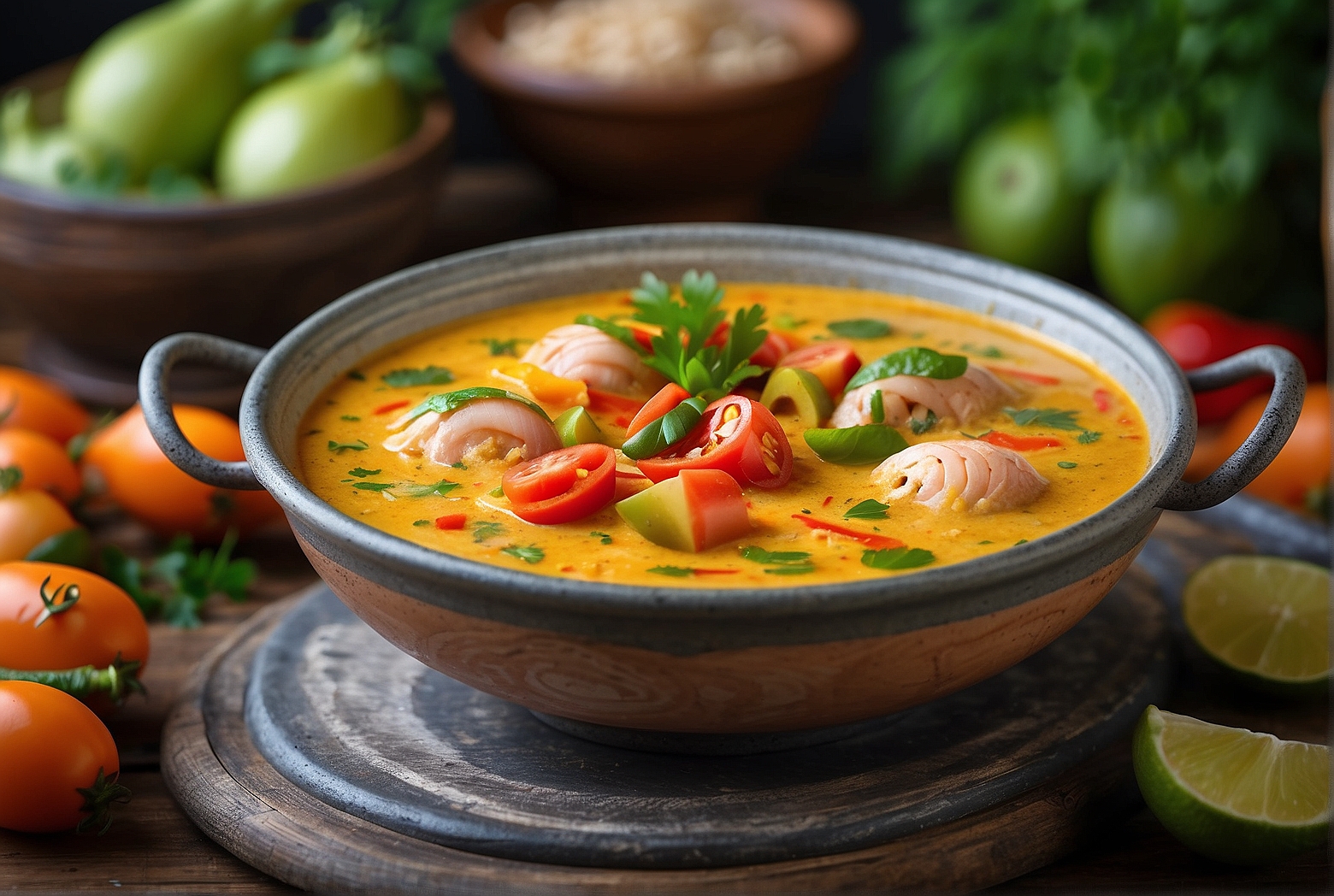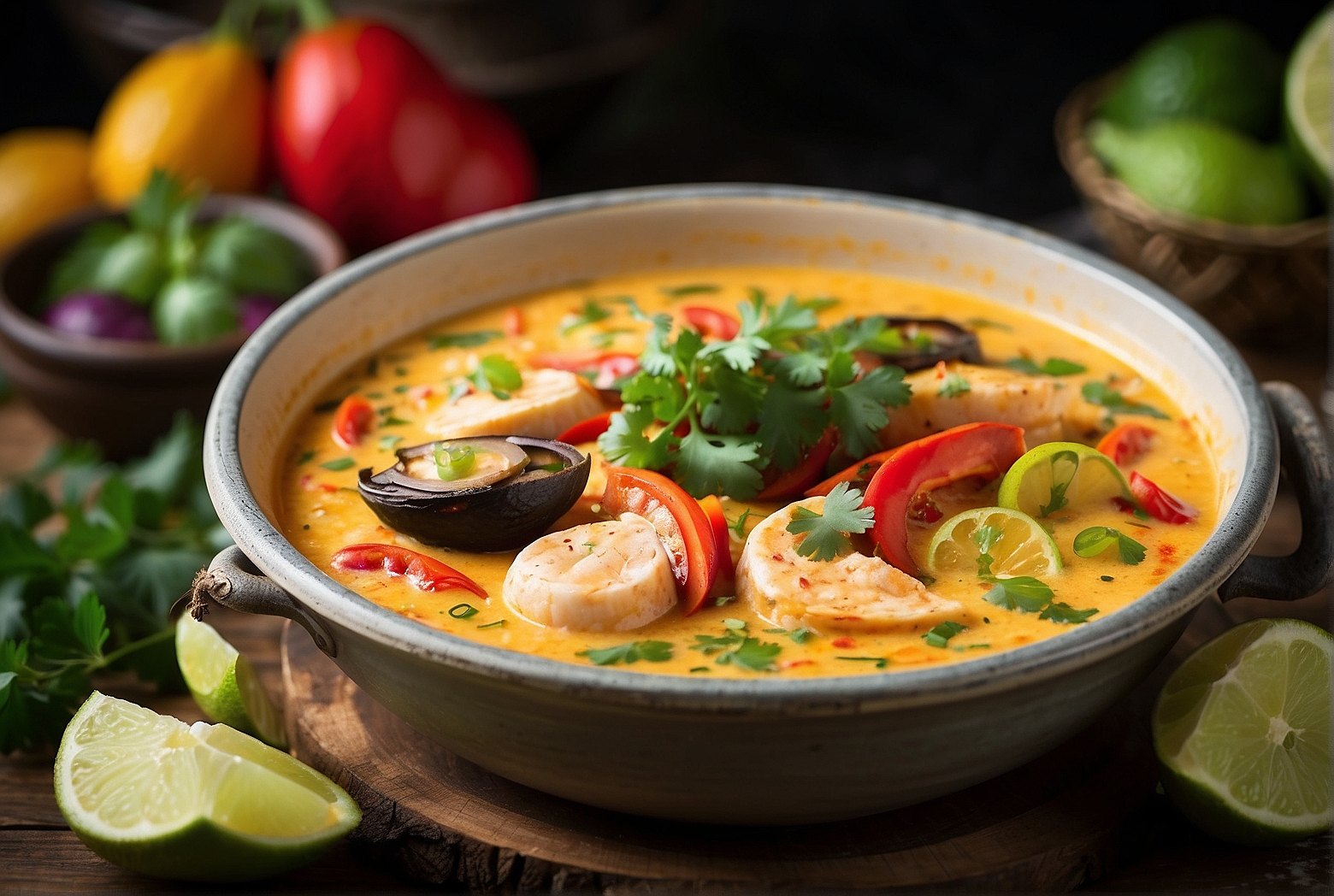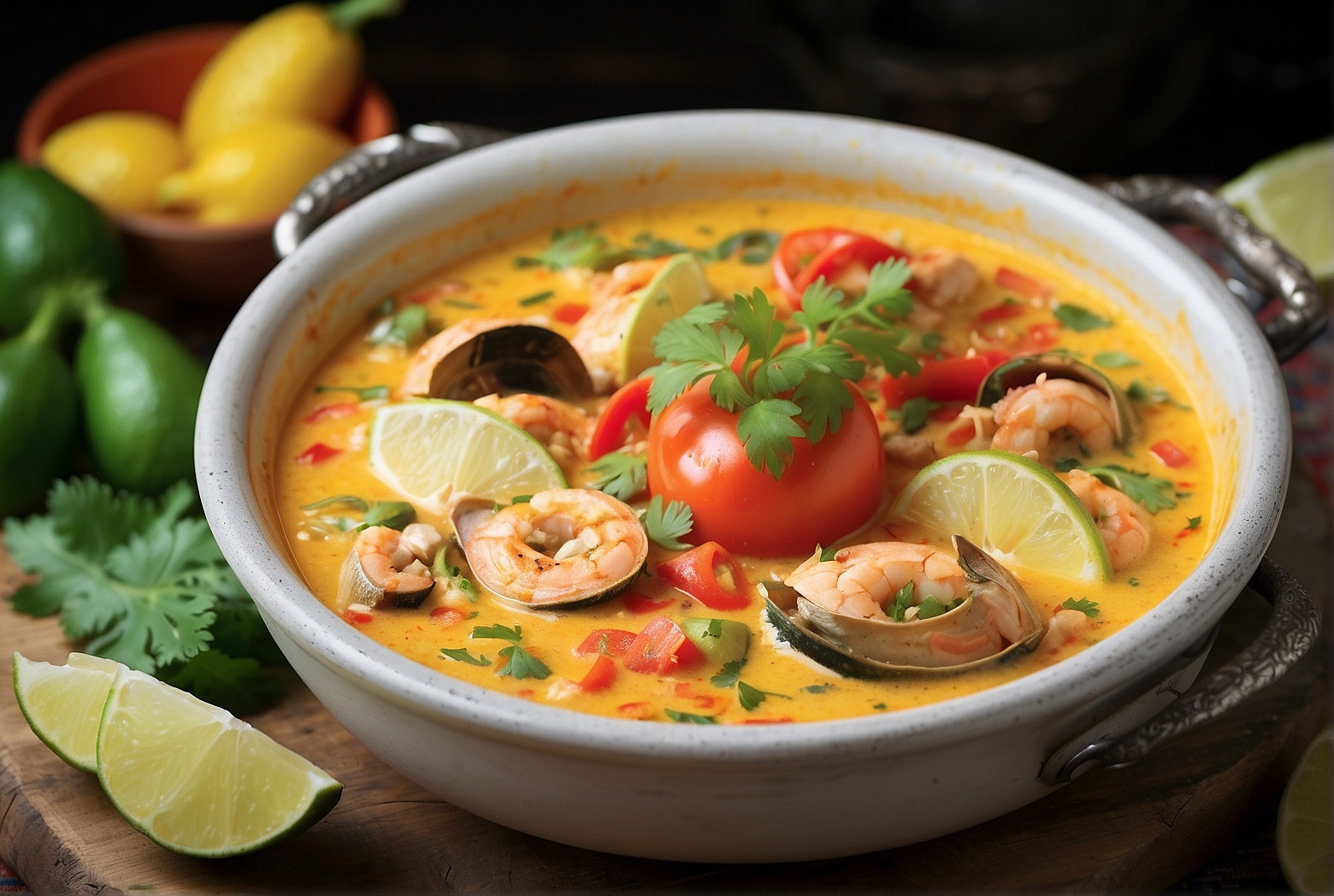If you’re craving a taste of Brazil, look no further! We’ve got the perfect recipe for you – Authentic Brazilian Moqueca. This traditional dish is bursting with flavors and offers a delightful culinary journey into South America. From the vibrant spices to the fresh seafood, this Moqueca recipe is guaranteed to transport your taste buds to the sunny shores of Brazil. So grab your apron, gather the ingredients, and get ready to embark on a delicious adventure in your very own kitchen. Let’s get cooking!
Authentic Brazilian Moqueca Recipe
Moqueca is a traditional Brazilian dish originating from the states of Bahia and Espirito Santo. It is a flavorful and aromatic seafood stew cooked in a rich broth made with coconut milk and dendê oil. This article will guide you through the process of preparing and cooking an authentic Brazilian Moqueca, along with some variations and serving suggestions.
Overview of Moqueca
Definition of Moqueca
Moqueca is a traditional Brazilian seafood stew made with a combination of fish or seafood, dendê oil, coconut milk, onions, garlic, tomatoes, bell peppers, cilantro, and lime juice. The dish is known for its vibrant flavors and is often served with steamed rice and farofa, a toasted cassava flour mixture.
Cultural Significance
Moqueca holds a significant place in Brazilian culture, particularly in the regions of Bahia and Espirito Santo where it originated. It reflects the country’s rich culinary traditions and cultural diversity, with influences from indigenous, African, and European cuisines.
Regional Differences
There are two main variations of Moqueca in Brazil РMoqueca Baiana and Moqueca Capixaba. Moqueca Baiana is characterized by the use of dend̻ oil, which gives it a distinctive orange color and a bold flavor. On the other hand, Moqueca Capixaba is prepared without dend̻ oil and is lighter in color and flavor. These regional differences add to the diversity and excitement of Brazilian cuisine.
Ingredients
Fish or Seafood
The choice of fish or seafood is crucial in preparing a delicious Moqueca. Opt for fresh and firm-fleshed fish such as red snapper, grouper, or cod. Shrimp, squid, or a combination of different seafood can also be used for a seafood medley.

Dendê Oil
Dendê oil, also known as palm oil, is a key ingredient in Moqueca. It imparts a distinct flavor and vibrant color to the dish. Look for authentic dendê oil in specialty stores or online. If you can’t find it, you can use a combination of olive oil and annatto seeds to mimic the flavor and color.
Coconut Milk
Coconut milk provides a creamy and tropical base for the Moqueca sauce. Choose canned or freshly extracted coconut milk for the best results. Look for unsweetened and full-fat coconut milk to achieve the desired richness.
Onions and Garlic
Onions and garlic form the aromatic base of the Moqueca. They add depth and flavor to the dish. Chop the onions finely and mince the garlic cloves to ensure even distribution in the stew.
Tomatoes
Fresh tomatoes add a sweet and tangy element to the Moqueca sauce. Choose ripe and juicy tomatoes, and dice them into small pieces for easy incorporation into the stew.
Bell Peppers
Colorful bell peppers not only enhance the visual appeal of the dish but also add a subtle sweetness. Use a combination of red, yellow, and green bell peppers, sliced into thin strips for an attractive presentation.
Cilantro
Cilantro provides a fresh and herbaceous note to the Moqueca. Finely chop the cilantro leaves, and reserve some for garnishing.

Limes
Lime juice adds a tangy and citrusy flavor to balance the richness of the Moqueca. Squeeze fresh limes and keep the juice ready for seasoning.
Salt and Pepper
Season the Moqueca with salt and pepper to taste. Adjust the amount according to your preference and the saltiness of the fish or seafood.
Optional Seasonings and Spices
You can enhance the flavors of your Moqueca by adding additional seasonings and spices such as paprika, cumin, coriander, or chili powder. These can be used sparingly to personalize the dish to your taste.
Preparation
Choosing the right Fish or Seafood
When selecting fish or seafood for your Moqueca, opt for fresh and high-quality ingredients. Avoid fish with a strong odor or slimy texture. The fish or seafood should be firm and able to hold its shape during the cooking process.
Marinating the Fish or Seafood
Marinating the fish or seafood adds an extra layer of flavor. Season the fish or seafood with salt, pepper, and a squeeze of lime juice, and let it marinate for at least 30 minutes before cooking. This step ensures that the flavors penetrate the fish or seafood.
Prepping the Vegetables
Finely chop the onions, garlic, tomatoes, bell peppers, and cilantro according to the recipe’s requirements. Having all the vegetables prepped and ready will make the cooking process smooth and efficient.
Preparing the Sauce
In a separate bowl, combine the coconut milk with the lime juice and optional seasonings. Whisk them together until well incorporated. This sauce serves as the base for the Moqueca and will infuse all the ingredients with its delicious flavors.
Combining Ingredients
Once all the ingredients are prepped, it’s time to bring them together. In a large pot, heat the dendê oil and sauté the onions and garlic until translucent. Add the marinated fish or seafood and cook for a few minutes until they start to turn opaque. Pour in the coconut milk mixture, followed by the diced tomatoes and bell peppers. Stir everything together gently and let the Moqueca simmer on low heat to allow the flavors to mingle.
Cooking Instructions
Pan vs. Clay Pot Moqueca
Traditionally, Moqueca is cooked in a clay pot, which helps to retain the heat and distribute it evenly. If you have access to a clay pot, it is highly recommended to use it to achieve an authentic taste and texture. However, if a clay pot is not available, a large, deep pan with a lid can also be used to cook the Moqueca.
Temperatures and Cooking Time
Moqueca is a slow-cooked stew that requires gentle heat and patience. Cook the Moqueca on low to medium heat to allow the flavors to develop gradually. The cooking time will vary depending on the type and size of fish or seafood used. As a general guideline, cook until the fish is cooked through and flakes easily with a fork. This usually takes about 20-30 minutes.
Layering Ingredients
To ensure even cooking and distribution of flavors, layer the ingredients in the pan or clay pot. Start with a base of onions and garlic, followed by the fish or seafood. Pour the prepared sauce over the fish or seafood, and top it with the diced tomatoes and bell peppers. This layering technique allows each ingredient to cook and infuse with the flavors of the others.
Simmering the Moqueca
Once all the ingredients are layered, cover the pan or clay pot with a lid and let the Moqueca simmer on low heat. Check occasionally to ensure that the stew is not boiling vigorously, as this can cause the fish or seafood to break apart. The gentle simmer allows the flavors to meld together beautifully, resulting in a rich and fragrant dish.
Final Touches
Towards the end of the cooking process, taste the Moqueca and adjust the seasonings if necessary. Add more salt, pepper, or lime juice according to your preference. Garnish with fresh cilantro leaves for a burst of freshness and vibrant color.
Serving Suggestions
Accompaniments
Moqueca is traditionally served with steamed white rice and farofa, a toasted cassava flour mixture. The rice serves as a neutral base to soak up the flavorful sauce, while the farofa adds a crunchy texture. Additionally, serve some lime wedges on the side for squeezing over the Moqueca, enhancing the tanginess.
Presentation Tips
To make your Moqueca visually appealing, carefully arrange the fish or seafood on a platter and ladle the sauce with the diced tomatoes and bell peppers over it. Garnish with a sprinkle of chopped cilantro and serve it with a flourish. The bright colors and enticing aroma will capture the attention of your guests.
Variations
Moqueca Capixaba
Originating from the state of Espirito Santo, Moqueca Capixaba is characterized by its simplicity and lightness. It is prepared without dendê oil and uses olive oil instead. The sauce is made with tomatoes, onions, and garlic, but without coconut milk. Moqueca Capixaba relies solely on the natural flavors of the fish or seafood and the vegetables.
Moqueca Baiana
Moqueca Baiana is the more well-known and widely loved version of Moqueca. It incorporates dendê oil, which gives it a distinct flavor and vibrant color. The combination of dendê oil, coconut milk, and spices creates a rich and aromatic broth. Moqueca Baiana typically includes onions, garlic, tomatoes, bell peppers, and cilantro, along with the fish or seafood.
Vegetarian Moqueca
For those who prefer a plant-based option, a vegetarian Moqueca can be just as delicious. Instead of fish or seafood, use vegetables such as eggplant, bell peppers, zucchini, and mushrooms. The preparation and cooking process remain the same, with the vegetables absorbing the flavors of the sauce and creating a hearty and satisfying stew.
Tips and Tricks
Choosing the Best Fish or Seafood
When selecting fish or seafood for your Moqueca, choose varieties that are readily available and sustainable. Fresh, firm-fleshed fish such as red snapper, grouper, or cod are popular choices for their mild flavor and ability to hold up well in the stew. If using shellfish like shrimp or squid, ensure they are fresh and of high quality.
Enhancing Flavor with Dendê Oil
Dendê oil is a crucial ingredient in Moqueca Baiana, adding a unique flavor and vibrant color to the dish. Use authentic dendê oil for the best results. If you can’t find it, you can make a substitute by infusing olive oil with annatto seeds, which will mimic the flavor and color of dendê oil.
Balancing Coconut Milk
Coconut milk is an integral part of Moqueca, providing a creamy and tropical undertone. Adjust the amount of coconut milk to achieve the desired richness and consistency. If you prefer a lighter Moqueca, use less coconut milk, or opt for light coconut milk. Conversely, if you prefer a richer and creamier stew, add more coconut milk.
Getting the Right Consistency
The consistency of the Moqueca should be slightly thick and velvety, without being too watery or overly thick. Ensure that the sauce has reduced slightly during the simmering process, allowing it to coat the fish or seafood evenly. If the stew is too thin, continue simmering until it reaches the desired consistency. If it is too thick, add a little water or fish stock to thin it out.
Adjusting Seasonings
Throughout the cooking process, taste the Moqueca and adjust the seasonings as needed. Add more salt, pepper, or lime juice to achieve a well-balanced and flavorful dish. Remember that it is easier to add seasonings gradually than to correct an over-seasoned dish, so taste and adjust gradually.
Preserving Leftovers
If you have leftover Moqueca, store it in an airtight container in the refrigerator. The flavors will continue to develop, making it even more delicious the next day. Gently reheat the Moqueca on the stovetop over low heat, being careful not to overcook the fish or seafood.
History of Moqueca
Origin of Moqueca
The origins of Moqueca can be traced back to the indigenous tribes of Brazil. The native people would cook fish or seafood in clay pots over an open fire, using local ingredients like dendê oil, coconut milk, and various spices. Over time, these cooking techniques and ingredients were influenced by the arrival of Portuguese colonizers and African slaves.
Indigenous Influences
Indigenous tribes residing along the Brazilian coast were skilled fishermen and used traditional methods to cook their catch. They would season the fish or seafood with local herbs and spices and cook it slowly in clay pots, resulting in a flavorful and nourishing stew.
Colonial and African Influences
With the arrival of Portuguese colonizers, new ingredients and cooking techniques were introduced. The Portuguese brought dendê oil, tomatoes, onions, and garlic, which became integral components of Moqueca. African slaves, who were brought to Brazil to work on plantations, contributed their culinary expertise and introduced coconut milk and additional spices to enhance the flavors of the stew.
Evolution of Moqueca
Moqueca has evolved over the centuries, reflecting the diverse cultural influences that shaped Brazil’s culinary landscape. It has become a beloved national dish, celebrated for its rich flavors and cultural significance. Today, Moqueca is enjoyed by Brazilians and visitors alike, and it continues to be a symbol of Brazil’s diverse and vibrant food culture.
Famous Moqueca Variations
Moqueca Baiana
Moqueca Baiana is the most famous variation of Moqueca, originating from the state of Bahia. It is characterized by the use of dendê oil, which gives it a vibrant orange color and a distinct flavor. The combination of dendê oil, coconut milk, and spices creates a rich and aromatic broth, while the fish or seafood, onions, garlic, tomatoes, bell peppers, and cilantro add depth and complexity to the dish.
Moqueca Capixaba
Moqueca Capixaba is a variation of Moqueca that hails from the state of Espirito Santo. Unlike Moqueca Baiana, it is prepared without dendê oil, resulting in a milder and lighter stew. Moqueca Capixaba focuses on the natural flavors of the fish or seafood, which are complemented by a simple sauce made with tomatoes, onions, and garlic. This variation showcases the freshness and quality of the ingredients.
Final Thoughts
Moqueca is not just a dish; it is an expression of Brazilian culture, history, and culinary prowess. By following this authentic Brazilian Moqueca recipe, you can embark on a flavorful journey and experience the vibrant flavors of Brazil right in your own kitchen. Whether you choose the Baiana or Capixaba variation or even a vegetarian version, the aromatic blend of spices, the creaminess of coconut milk, and the balance of fresh ingredients will transport you to the sun-drenched beaches of Brazil. So gather your ingredients, put on some Brazilian music, and savor the authentic flavors of Moqueca. Bom apetite!
